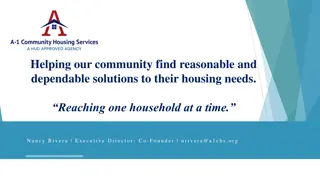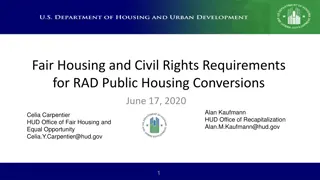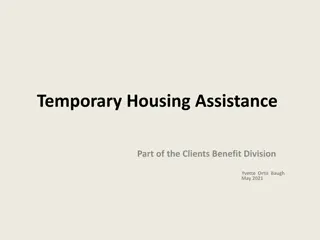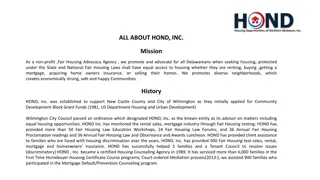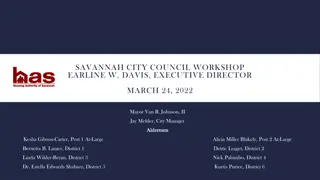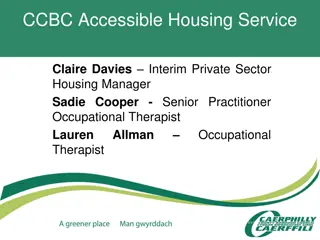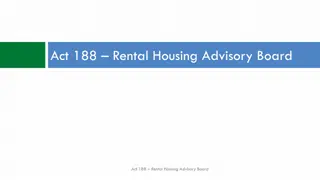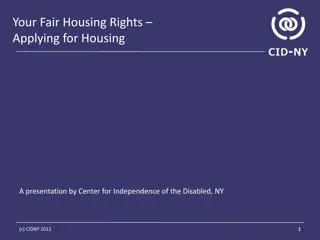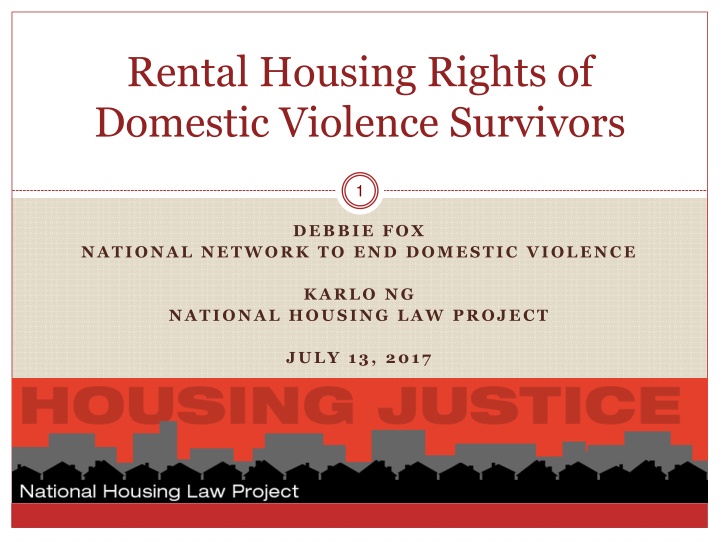
Rental Housing Rights of Domestic Violence Survivors
Explore the rights of domestic violence survivors in rental housing, covering topics like eviction prevention, access to housing, common challenges, and case studies. Learn about relevant laws and resources to support survivors effectively.
Download Presentation

Please find below an Image/Link to download the presentation.
The content on the website is provided AS IS for your information and personal use only. It may not be sold, licensed, or shared on other websites without obtaining consent from the author. If you encounter any issues during the download, it is possible that the publisher has removed the file from their server.
You are allowed to download the files provided on this website for personal or commercial use, subject to the condition that they are used lawfully. All files are the property of their respective owners.
The content on the website is provided AS IS for your information and personal use only. It may not be sold, licensed, or shared on other websites without obtaining consent from the author.
E N D
Presentation Transcript
Rental Housing Rights of Domestic Violence Survivors 1 DEBBIE FOX NATIONAL NETWORK TO END DOMESTIC VIOLENCE KARLO NG NATIONAL HOUSING LAW PROJECT JULY 13, 2017
2 Polling Question #1: How often do you assist clients with issues pertaining to keeping the housed (eviction prevention), accessing and maintaining housing (once housed)? (a) Never (b) Very rarely (c) Frequently (d) All the time
3 Polling Question #2: What housing challenges do the DV program participants you work with commonly experience? (Select all that apply.) (a) Barriers to terminate leases (b) Evictions for reasons related to DV (c) Admission denials for reasons related to DV (d) Emergency transfers (e) Finding alternative, safe, and affordable housing (f) Access to crisis shelter or longer-term homeless services housing support (f) Other (please enter responses in chat box)
Today We Will Cover 4 The Violence Against Women Reauthorization Act of 2013 and related HUD and USDA Rural Development guidance California laws on the housing rights of survivors Fair housing laws that provide safeguards for survivors
Case Study: Mrs. Farsi 5 Mrs. Farsi has been married to Mr. Farsi for 30 years. Both are documented monolingual Farsi-speaking immigrants. Mr. and Mrs. Farsi have a Section 8 voucher and were living in a 3- bedroom unit with their adult son. Mrs. Farsi moved out after her husband burned her and is staying with Mr. Farsi s family because she has no other relatives in the U.S. Mrs. Farsi filed a HUD VAWA Self-Certification Form with the Housing Authority recounting the abuse and her husband s statement that "If this wasn't America you'd have already been dead. Mrs. Farsi wants to stay in the unit and have the voucher be placed in her name. For over two months, the Housing Authority has not responded to her request.
6 Mrs. Farsi finds out that only her husband s name is on the voucher. The Housing Authority tells her that the voucher is Mr. Farsi s and she cannot get the voucher without her husband s written permission. Polling Question #3: Can Mrs. Farsi still have the Section 8 voucher be transferred to her name if she income qualifies for the program? (a) Yes, but only with her husband s consent. (b) Yes, without her husband s consent. (c) No (d) Unsure
What Programs Does VAWA Cover? 7 HUD Programs Public Housing Section 8 vouchers 236 Multifamily rental housing 221d3/d5 Below Market Interest Rate (BMIR) HOME HOPWA (Housing Opportunities for People w/AIDS) McKinney-Vento Homelessness Programs (includes ESG; CoC) Project-based Section 8 Section 202 Supportive Housing for the Elderly Section 811 Supportive Housing for People with Disabilities Housing Trust Fund Department of Agriculture Rural Development (RD) Multifamily Department of Treasury/IRS Low Income Housing Tax Credit (LIHTC)
Who Does VAWA Protect? 8 VAWA covers people who are subject to: Domestic violence: Any felony or misdemeanor crimes of violence committed by: a current/former spouse or intimate partner, person with whom the victim shares a child, person who is or has cohabitated with the victim; a person against a victim protected from acts under state/local domestic and family violence laws. Dating violence: Violence committed by a person who is/was in a social relationship of intimate nature with victim as determined by considering three factors Sexual assault: Any nonconsensual sexual act prohibited by law Stalking: Any conduct directed toward a specific person that would cause a reasonable person to fear for safety or suffer substantial distress VAWA applies to applicants and tenants
VAWA Documentation Options 9 1. Self-certification form New HUD VAWA self-certification form for all HUD programs HUD Form 5382 (all HUD programs) now translated! 2. Police, court or administrative record Record can be from a federal, state, tribal, territorial, or local entity or administrative record. 3. Statement from third party Can be from a victim service provider, medical professional, mental health professional or attorney. Must be signed by both third party and survivor under penalty of perjury. 4. Statement or other evidence (housing provider s discretion)
Proving Abuse 11 Survivor gets to choose documentation option Housing providers must accept whatever documentation the survivor gives. Housing providers must accept self-certification. Survivors do not have to contact the police or initiate legal proceedings against abuser or perpetrator. Only exception when there is conflicting evidence, housing providers can ask for additional documentation Housing providers cannot judge the merits of claims of VAWA crimes.
Family Breakups and Section 8 Vouchers 12 If a family breakup results from the violence or abuse, the PHA mustensure that the victim retains assistance. Many housing authorities are not aware of this VAWA obligation.
How Can We Help Mrs. Farsi Get the Voucher? 13 Mrs. Farsi can request from the housing authority that the voucher be transferred to her name due to the violence or abuse (orally or via written demand letter) We recommend written demand letters (NHLP has samples)
How Can We Help Mrs. Farsi Get the Voucher? 14 In deciding who gets the voucher, the housing authority can consider: Whether remaining family members should get the assistance; Interest of minor children or of ill, elderly, or disabled family members; Whether family members were forced to leave unit because of domestic violence, dating violence, sexual assault, or stalking; Whether any family member is receiving protection as a victim of domestic violence, dating violence, sexual assault, or stalking; Other factors specified by the Housing Authority Who should get the voucher?
How Can We Help Mrs. Farsi Get the Voucher? 15 For more than 2 months, the Housing Authority has not responded to or issued Mrs. Farsi a voucher to move. What can be done?
16 Mrs. Farsi finally receives the Section 8 voucher in her name. She does not feel safe staying in her current unit (husband still has the keys) and would like the locks to be changed. Mrs. Farsi would also like to terminate her lease once she finds another unit where she can use the voucher. Polling Question #4: Can Mrs. Farsi get the locks changed? Can she break her lease? (a) Yes (b) No (c) Unsure
Changing the Locks 17 CA Civil Code 1941.5 where abuser is not tenant of the same unit. Civil Code 1941.6 where victim and abuser live together. Under section 1941.5 (do not live together): Landlord must change locks within 24 hours of receiving copy of court order or police report Court order or police report must have been issued within the prior 180 days Request must be made in writing If the landlord refuses, tenant may change the locks without the landlord s permission
Changing the Locks 18 Requirements of sections 1941.5 and 1941.6 are almost the same EXCEPT that if both survivor and abuser live together: (1) The victim cannot use a police report, only a court order; and (2) Court order must explicitly exclude the abuser/tenant from the premises. NHLP s CA Lock Change Packet
Breaking the Lease 19 Must notify landlord in writing Must attach copy of protective order, copy of police report or documentation by qualified third party The documentation must be based on information received while the third party was acting in his/her professional capacity Protective order or police report issued within last 180 days; no time limit on third-party documentation Must pay rent for 14 days following notice If the survivor vacates before the 14-day period expires, and the premises are re-rented, the survivor s rent must be prorated. NHLP s CA Early Lease Termination Toolkit
Section 8 Voucher Portability 20 Many housing authorities prohibit Section 8 voucher tenants from moving during the 1st year of their lease, or from moving more than once during a 12- month period. However, there is a VAWA exception for survivors. These policies do NOT apply when the move is needed for safety.
21 Mrs. Farsi is looking for an apartment that is suitable for her and her son and where the landlord will take the voucher. She discovers that prospective landlords are denying her rental application because the Housing Authority is providing negative references about her prior tenancy due to DV incidents. Polling Question #5: Is this legal? (a) Yes (b) No (c) Unsure
VAWA Confidentiality 22 Information submitted by survivor under VAWA must be maintained in strict confidence . Housing providers cannot allow anyone administering assistance or employees to have access to confidential information unless explicitly authorized. Confidential information will not be entered into shared database or disclosed to others, except if disclosure is: Requested or consented to in writing by survivor in time- limited release; Required for use in eviction or termination hearing; or Otherwise required by law.
Fair Housing Laws 23 Fair housing laws apply to domestic violence survivors through a gender discrimination theory Fair housing case involving negative references by former landlord due to DV Dickinson v. Zanesville, 975 F.Supp.2d 863 (S.D. Ohio 2013)
Admissions 24 PHAs, landlords, and owners may not deny an applicant housing on the basis or as a direct result of an applicant having been a survivor of domestic violence, dating violence, sexual assault, or stalking. Adverse factors resulting from the abuse (e.g. poor credit history, poor rental history, or criminal history) Notice PIH-2017-08 (HA): Adverse factors may seem unrelated to VAWA crimes but adverse factor may exist b/c of underlying experience of VAWA crime; notice includes helpful examples of adverse factors that may be a direct result
Adverse Factors as Direct Result of VAWA Crimes 25 To trigger an analysis of whether an adverse factor is a direct result of domestic violence, dating violence, sexual assault, or stalking, the applicant/tenant must: (1) Inform PHA/owner that they are a survivor of a VAWA crime; and (2) Provide sufficient information for PHA/owner to make a determination re: the adverse factor. Without a request for VAWA protections, PHAs/owners are not required to determine whether an adverse factor is a direct result of a VAWA crime.
Case Study: Rhonda 26 Rhonda lives in public housing and is in an abusive relationship with Mike, who does not live with her. Rhonda is afraid to leave Mike and lets him come to her apartment because she knows that Mike will cause a disturbance until she lets him in. One day, when Mike was visiting, he became upset over some of Rhonda s texts and threw her against a wall. A week later, Rhonda received an eviction notice from the housing authority because of nuisance . Rhonda doesn t want to stay in the unit and doesn t see the point in fighting the eviction. She comes to you seeking advice about getting away from Mike. Question: What issues do you see?
HUD Notice and Self-Certification Form 27 Housing provider must provide HUD VAWA housing rights notice (Form HUD-5380) and self-certification form (Form HUD-5382) to applicants and tenants (1) at the time an applicant is denied admission or assistance; (2) at the time individual is admitted or given assistance; and (3) with any notification of eviction or assistance termination. Existing tenants must receive notice and form by December 16, 2017. HUD has translated HUD notice and form into 11 languages.
Eviction Protections 29 CA law A landlord cannot evict a tenant based upon an act of domestic violence, sexual assault, human trafficking or stalking, or abuse of an elder or dependent adult. Tenant must have (1) a R.O. or police report issued in the last 180 days and (2) the person on the R.O. may not be a tenant of the same dwelling unit.
Eviction Protections 30 CA law If tenant has already used the eviction defense, landlord can still evict if either of the following apply: Tenant allows the perpetrator to visit the property, OR Landlord reasonably believes that the perpetrator poses a physical threat to other tenants or to the right to quiet possession Landlord must give at least 3 days notice to the tenant to correct a violation of the above. NHLP s CA Eviction Defense Brochure
Eviction Protections 31 VAWA PHAs, landlords, and owners may not evict a tenant on the basis or as a direct result of their status as a survivor. Crimes against a survivor directly relating to the abuse are not grounds for evicting the survivor or terminating their rental subsidy. An incident of actual or threatened abuse does not constitute a serious or repeated lease violation or good cause for evicting the survivor or terminating their rental subsidy.
Eviction Protections 32 VAWA Housing authorities and owners can still evict if they can demonstrate an actual and imminent threat to other tenants or employees at the property if the survivor is not evicted. Threat consists of a physical danger that is real, would occur within an immediate timeframe, and could result in death or serious bodily harm. Factors to be considered include the duration of the risk, the nature and severity of the potential harm, the likelihood that the harm will occur, and the length of time before the harm would occur. 24 C.F.R. 5.2005 Eviction should occur only if there is no other action to be taken that would reduce or eliminate threat.
Eviction Protection for Police Calls 33 Local agencies cannot require a landlord to terminate a tenancy based on an act against a tenant or a tenant s household member that constitutes domestic violence, stalking, human trafficking, or abuse of an elder or dependent adult, or based on the number of calls made by a tenant to a 9-1-1 system reporting such acts.
Emergency Transfers 34 Under VAWA, housing providers must have adopted an emergency transfer plan (ETP) by June 14, 2017. ETPs must provide that a tenant who is a survivor of a VAWA crime qualifies for an emergency transfer if: The tenant expressly requests the transfer; and The tenant: reasonably believes there is a threat of imminent harm from further violence if the tenant remains within the same dwelling unit OR the sexual assault occurred on the premises during the 90-calendar-day period before the transfer request. ETPs must allow tenants to seek internal and external emergency transfers at the same time if no safe unit is immediately available. Safe unit defined as unit that the survivor believes to be safe.
VAWA and VOCA FY 18 Appropriations Prcoess 35 House Commerce, Justice, Science (CJS) Appropriations Subcommittee released its Appropriations bill on June 28th. It includes level funding for VAWA and a significant increase in VOCA funds. This is the first step in a long Appropriations process.
VAWA: $482.0 million (no transfer from VOCA) 36 VAWA grants remain level funded from the FY17 levels, except for a small increase in the National Institute of Justice (NIJ) funding of an $0.50 million. VAWA 2018 up for renewal FVPSA: Still do not know funding outlook
VOCA: $4.63 billion 37 The bill increases the VOCA cap from $2.57 billion to $4.60 billion (with NO transfers)!* Confirmed with House CJS staff, that this number does not include transfers to non-VOCA programs. *Remember $2.57 billion included transfers to VAWA - the $4 billion proposed in this bill has no transfers CJS committee did not allocate a specific Tribal funding stream. Instead, they have instructed States with Tribal populations allocate a proportionate amount to Tribal programs.
Housing and Urban Development 38 Skinny budget called for an 14% cut in HUD programs upwards to 7 billion in funding Includes many HUD program including CDBG, HOME, Choice Neighborhoods, Section 8 based rental assistanct Transportation, Housing & Urban Development (T- HUD) marking up budget in mid July and hopefully HUD will maintain level funding
Resources 39 CA Early Lease Termination Toolkit CA Lock Changes Packet CA Eviction Defense Packet Updated VAWA 2013 brochure HUD s final VAWA 2013 rule HUD Notice PIH-2017-08 (HA) HUD s VAWA self-certification form HUD s notice of occupancy rights USDA Rural Development s updated notice on VAWA implementation
Thank You! 40 Debbie Fox National Network to End Domestic Violence dfox@nnedv.org safehousingpartnerships.org www.womenslaw.org Karlo Ng National Housing Law Project kng@nhlp.org www.nhlp.org/OVWgrantees

